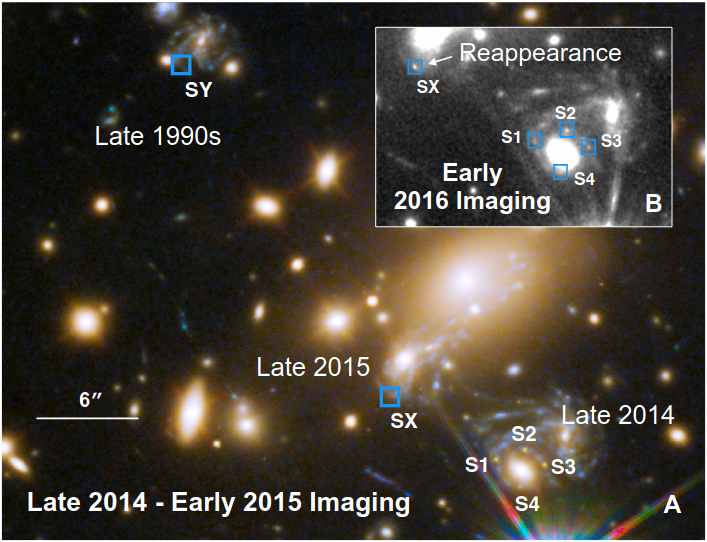Reappearing Supernova Allows First-of-its-Kind Measurement of Universe's Expansion Rate
Drs. Birrer and von der Linden and international collaborators have successfully used
a first-of-its-kind technique to measure the expansion rate of the Universe. Their
data provides insight into a longstanding debate in the field and could help scientists
more accurately determine the Universe’s age and better understand the cosmos.
 An image from the paper, showing (A) movement of the host galaxy and supernova over
time and (B) the four images taken in 2014 (S1-4) and the reappearance in 2015 (SX).
An image from the paper, showing (A) movement of the host galaxy and supernova over
time and (B) the four images taken in 2014 (S1-4) and the reappearance in 2015 (SX).
"The prediction and subsequent observation of the fifth image of Supernova Refsdal
was a great success of our cosmological model based on General Relativity and the
mysterious dark matter, ... yielding a precise measurement of the Hubble constant
from a lensed supernova - this supernova just keeps on giving!"
- Dr. von der Linden
The measurement yields a result consistent with predictions based on the cosmic microwave
background (CMB), and will help in contributing to settle disagreements between different
measurement methods giving different values for the Hubble constant -- a constant
that helps describes how our universe is expanding.
"The measurement of the expansion rate of the Universe is a rollercoaster. While a
few years ago, most strong lensing measurements yielded higher values in tension with
the cosmic microwave background estimates, more recent measurements and revised methodology
has resulted in lower values. This study does not provide the last word, but corroborates
a trend."
- Dr. Birrer
In 2014, the supernova was discovered and multiply imaged (the same supernova was captured appearing four times in a single frame). Gravitational lensing caused by a galaxy cluster bent and magnified the light to appear in the shape of an Einstein cross. By predicting the location of the next image of the supernova and capturing it again, the researchers were able use a theory developed in the 60s that had previously been impossible to use without these specific occurences.
The paper, published in Science, may be found here.
